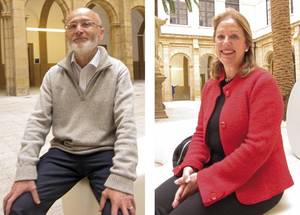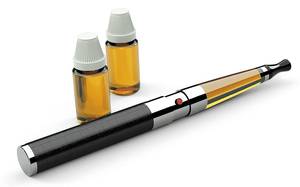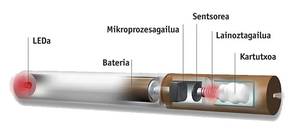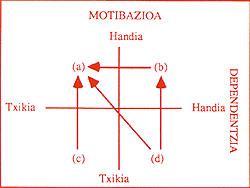Electronic cigarette: doubts between vapors
2014/07/01 Galarraga Aiestaran, Ana - Elhuyar Zientzia Iturria: Elhuyar aldizkaria

"We do not know, but at least we know that we do not know." It is the recognition of Francisco Javier Ayesta. Ayesta is a professor of pharmacology at the University of Cantabria and expert in smoking. These words were exposed in a day on electronic cigarette organized by the University of Deusto, with which the rest of experts agreed.
La de Deusto was one of the days that lately are carrying out researchers and professionals. To analyze whether electronic cigarette is a problem or a solution, in collaboration with Ayesta, public health experts from the Government of Catalonia and the City Council of Vitoria-Gasteiz (Esteve Saltó and Joseba Zabala), an epidemiologist from the Catalan Institute of Oncology (Esteve Fernández) and the head of the Unidad de Tabaquismo del Galana.
From the beginning they accepted that they had more questions than answers. In fact, so far, few studies have been conducted on the effects of electronic cigarettes, many of which present methodological errors. They recalled that this is a new and very heterogeneous product, which makes it very difficult to carry out good research, access to evidence and obtaining solid conclusions.
At the base, all electronic cigars have a similar function. By means of a resistance and a battery, a liquid containing nicotine is heated and evaporated, and this vapor is inhaled by the consumer. Chinese pharmacist Hon Lik patented this system in 2003, which although it took little time to enter the European market, has spread rapidly in recent years. Thus, in 2012 e-cigarette vendors obtained a profit of 500 million euros.
The effort of the tobacco industry has had a great influence on this success. And it is that for him it is a unique opportunity to recover the market lost by the hardening of tobacco measures. For this reason, in the first place, tobacco companies have begun to produce electronic cigarettes or have been captured by the producer and, subsequently, have put special force in advertising to appear as healthy substitutes of traditional cigarette.
In another case, the strategies and iconography they use to sell are the same ones that 50 years ago: the consumption of electronic cigarettes highlights the masculine virility (masculinity), gives glamour to women and turns young people into adults.
In fact, health care providers should not worry about the attractiveness of electronic cigarette, if it has no negative consequences for health. However, the World Health Organization itself warned in July 2013 that "the safety of nicotine electronic devices is not scientifically demonstrated. The risk for the health of users is to be determined. Furthermore, scientific evidence has shown that the product is very variable in the amount of nicotine and other chemicals it seems, and that consumers do not have the opportunity to know exactly what the product they purchase is.”
Analyzing impacts
The experts who participated in the day of Deusto shared the position of the WHO. They consider it fundamental to maintain the precautionary principle until the evidence is solid. But they went further and raised several questions and doubts. For example, if it is true that inhaling does less harm than smoking, can an electronic cigarette be a good option to help quit tobacco, or to offer a less harmful substitute to combative smokers?
This topic generates a great debate because it is not yet clear to what extent electronic cigarette is better than usual for health. Ayesta recalled that the influence of any substance depends on the way of administration. He gave as an example the infusion of coca, cocaine, hydrochloride and crac; the first is drunk, the second is snowed and the third is burned and inhaled. Of these three, the third is the hardest, the one of greater and faster influence.
In the case of tobacco, with conventional cigarettes, Ayesta stated that inhaled smoke is the most effective, and that the influence is much lower if they are not inhaled. The spray, on the other hand, is the hardest system (equivalent to inhaling smoke when burning) and the lighter patches. Well, according to Ayesta, the impact of electronic cigarette is similar to the spray.
However, Ayesta recalled that the composition of the liquid containing electronic cigarettes varies greatly from one to the other, although there is a rule in nicotine concentration. Specifically, the European Union has recently established a maximum nicotine concentration of 20 mg/ml. Ayesta, however, indicated that this concentration was enough to cause addiction and other consequences of nicotine.

What worries doctors the most is cardiovascular risk. The main risk factor for a heart attack is hypertension, followed by tobacco. In addition, the risk does not increase with the dose, since by burning a single cigarette a day, after 20 years, cardiovascular risk increases by 30%. Based on the data obtained so far, Ayesta believes that electronic cigarettes are less dangerous than conventional cigars, "about half of what they generate," he said.
Other consequences of conventional cigarettes are not related to nicotine. And in them there are differences with electronic cigarette. Thanks to this, the toxicity of electronic cigarette is much lower than usual. Ayesta, however, added a nuance: "We have to be careful in saying this, because we can't make sure. But it is difficult for the electronic cigarette to be more toxic than normal, because it is very toxic."
For example, the traditional cigarette contains many substances that increase the risk of lung cancer, and it seems that in the liquid used by electronic cigarettes there are not as many carcinogenic substances, or at least in appreciable quantities, since they all contain nitrosamines and propylene glycol, but in very low concentrations.
On the contrary, liquids contain a lot of additives, more than 600 in general. These additives, used in the food industry, are edible safe, but are not shown to cause damage during heating and inhalation. In this regard all those present returned: "More research is needed."
Less in the environment
Another of the topics that provoke a great debate is the relative to its possible influence on the environment. It is often said that they only pour water vapor, but on the day of Deusto Esteve Fernández showed that this belief is wrong.
Fernandez is an epidemiologist at the Catalan Institute of Oncology and the results of his research have shown that the electronic cigarette releases an amount much lower than usual (approximately 10 times less). "But loose, loose," stressed Fernández. And he added that "people associate smoke and the smell of tobacco to the diffusion of substances that give off tobacco, but nicotine extends much more than smoke and smell. We have also found it in the hair of cloistered nuns and we are sure they have never burned tobacco."
As for particles poured along with smoke, the electronic cigarette also emits much less than usual. However, one of the experiments was carried out inside a car and saw that the amount of nicotine released by electronic cigarette and the number of particles exceeded the limits considered safe by WHO.
Therefore, he concluded that users of electronic cigars endure a passive exposure, much lower than usual, but that only releases enough water vapor to cancel it.
To leave or cause less damage?
It is also debatable whether smoking cessation therapy can be adequate. Although in advertising they bet on this idea, for the experts gathered in Deusto this use is not recommended at all.
Juana Umaran is one of the most talked about the subject. He is specialized in cardiology and is responsible for the Smoking Unit of the Galdakao Hospital. According to him, more and more smokers use the electronic cigarette to quit smoking or to reduce consumption. But not only they, but also ex-smokers and non-smokers. "That's what concerns me most," Umaran acknowledged. "Consumers consider that electronic cigarette has no harmful effects or, in any case, is insignificant. But we do not know if that is so."
According to Umaran, more and more people have started to use the electronic cigarette to quit smoking. "And these discard other therapies. And then what happens? For many consume both. In fact, the electronic cigarette not only strengthens physical dependence, but also the gestures, and also the social. Therefore, it is very difficult for a smoker who begins to consume electronic cigarette to leave tobacco."
In addition, unlike the therapies used in the Smoking Unit to quit smoking, they start without any control. "In this way, your effort will hardly succeed and may pose a risk to health. Is there less risk than conventional cigarettes? This is probably the case, but it is not demonstrated to what extent.”
He warned that sometimes the risk may be high and recalled the two cases of lipoid pneumonia by the use of electronic cigarette. One of them was diagnosed in 2012 in the United States and another in Galicia this same year. The patient had spent ten months consuming electronic cigarette with the aim of quitting smoking.
He was treated in the hospital of La Coruña and, as the doctor explained, there is no doubt that the cause of the disease was the electronic cigarette. This type of pneumonia is explained by the accumulation of glycerin in the lungs, whose origin comes from the e-cigar liquid. The patient emptied 5 containers a day (equivalent to 5 packs of cigarettes a day).
Taking into account public health
In the absence of clear conclusions on the effects of electronic cigarette, it is difficult for health managers to adopt common and unequivocal attitudes. In general, two positions are being imposed at the international level. On the one hand, there are those who justify not doing harm until demonstrating the opposite, who are supporters of acting flexibly. On the other hand, there are those based on the precaution principle, which prefer to regulate and limit to prevent possible damage.
Between these two positions, the health managers of Catalonia and the Autonomous Community of the Basque Country have decided, among others, to protect the precautionary principle. Therefore, they share the WHO approach. And not only for individual health, but, above all, for the whole of society.
Josu Zabala, doctor of Public Health of the City of Vitoria-Gasteiz, for example, pointed out in the day of Deusto that he is not in favor of prohibiting electronic cigarettes, but that he considers it necessary to regulate it.
According to Zabala, the use of electronic cigars should not be associated with therapies to quit smoking, but to leisure consumption. In this sense, he mentioned some points that can promote non-responsible consumption, such as the attraction that can have in young people. And it is that it does not have the bad image that it has for some the traditional cigarette, and sell those who like, in any store (of strawberries, of chocolate...).
On the other hand, most experts fear that the fact of being blurred with electronic cigarettes can even lead to a decline in smoking prohibition in public places. This was manifested by those present in Deusto. Zabala himself pointed out that smoke-free spaces must also become "spaces without steam".
Neither Zabala nor other experts doubted the creation and implementation of a specific regulation for the protection of public health. According to Zabala, this regulation, in addition to the product itself (components, etc. ), should take into account advertising, marketing, packaging, points of sale, etc.
Therefore, despite “more questions than answers” about e-cigarette, experts have a broad consensus on the need to be based and regulated on the precautionary principle and hope that the regulations of both the European Union and the United States (FDA) will soon emerge. Meanwhile, the questions remain in the air.

Gai honi buruzko eduki gehiago
Elhuyarrek garatutako teknologia







